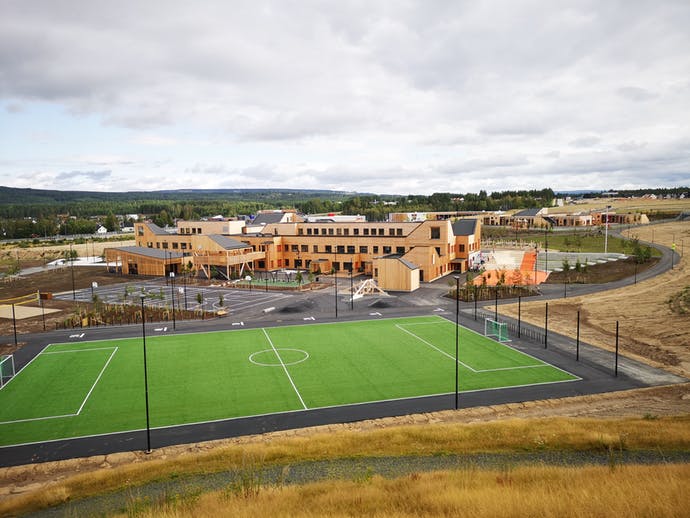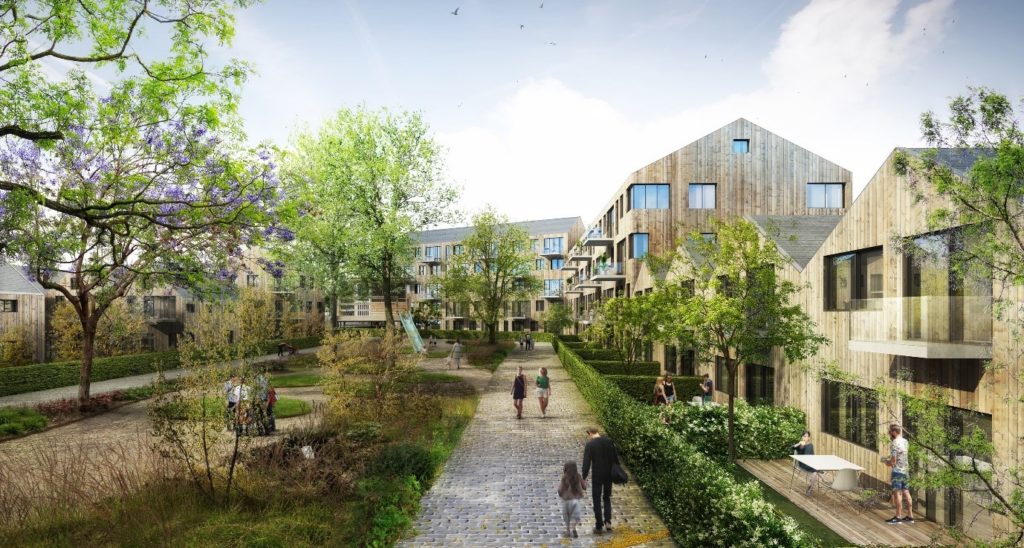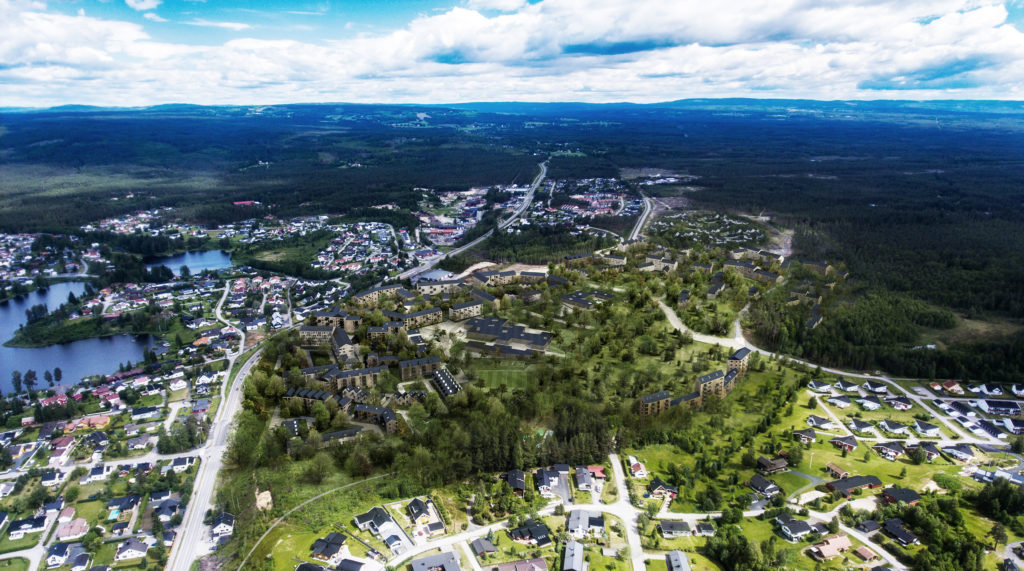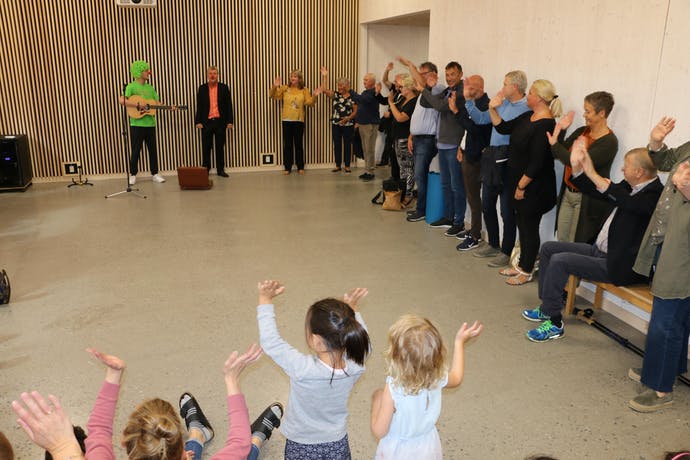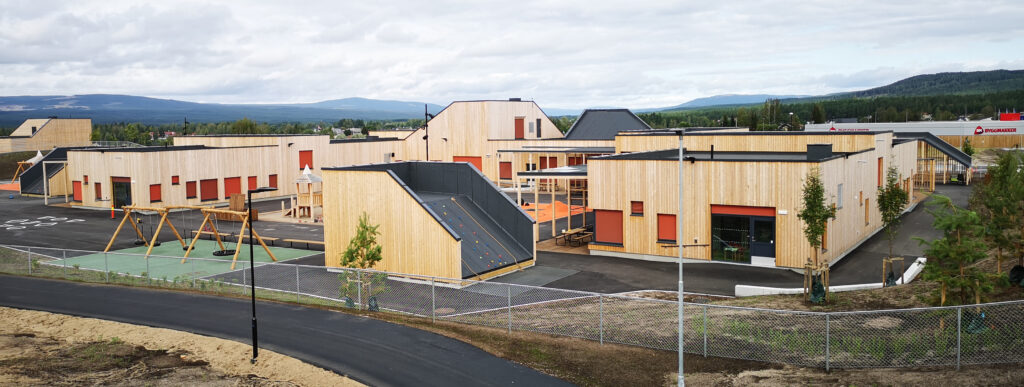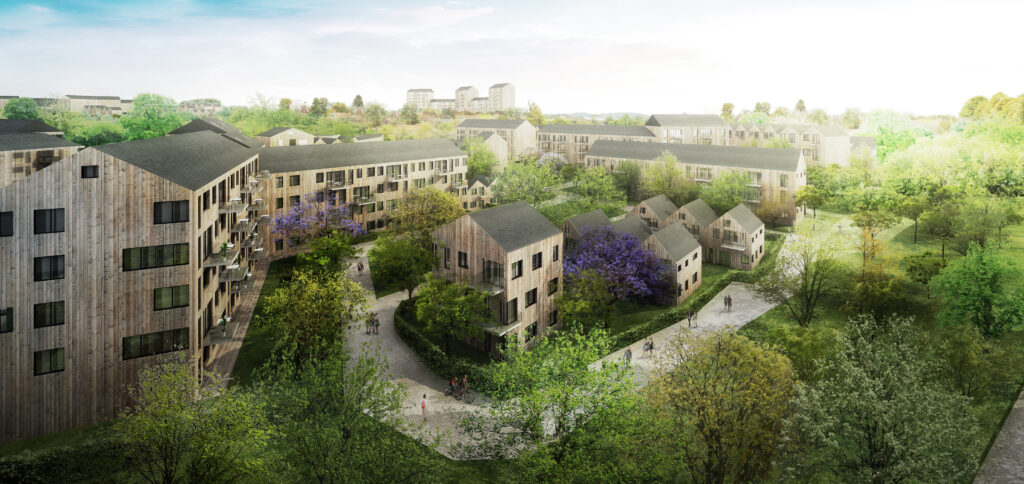
Ydalir, Elverum
Pilotprosjekt: Ydalir, Elverum
- Lokasjon: Elverum municipality, Norway
- Hva bygges: Residential area with school and kindergarten
- Konstruksjon: New construction, 1 000 dwellings (ca. 100 000 m2), a school and a kindergarten
- Størrelse: 430 000 m2
- Prosjekteier: Elverum Municipality
- Kontakt på ZEN senteret: Judith Thomsen
- Interessenter: Elverum Municipality
- Involvering fra våre forskere: ZEN researchers are involved in several life-cycle analyses regarding the project, the use of materials and user involvement.
- Prosjektstatus: The school and kindergarten are built.
Prosjektet fokuserer på følgende ZEN-kriterier:
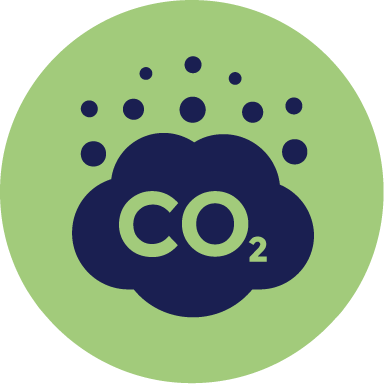









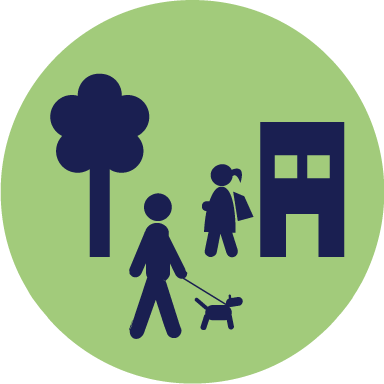



Ydalir Living Lab
Ydalir living lab skal undersøke «hva er det gode liv i Elverum?». Dette handler om å samle historier fra Elverums befolkning om hva det gode liv er i dag, hva det har vært før og ønskene for fremtiden. Vi ønsker å snakke med ulike grupper fra befolkningen; barn, voksne, eldre, kvinner og menn, samt ifra ulike kulturelle bakgrunn. Vi ønske å se om det er forbindelser mellom den bærekraftige framtiden som ZEN skisserer og ønsker og målsettinger til Elverums befolkning. ZEN er opptatt av bærekraftig byutvikling og boligutvikling, og de fysiske omgivelser i Elverum vil være sentrale i spørsmålene som vil bli stilt.
Men «det gode livet i Elverum» er et ganske bredt konsept og vi vil være interessert i å høre alle historiene som kan knyttes til hvordan det er å bo i Elverum. For eksempel opplevelser fra andre verdenskrig, barneleker, jordbruk, skogbruk, handel og industri, å flytte til Elverum, å vokse opp i Elverum, kafekulturen, husflid og turer i nærmiljøet, skateparken, å gå på skolen, husbygging og sentrumsutvikling.
Oppstart for Ydalir living lab er 08.09.2020. For mer informasjon, ta kontakt med Ruth Woods (https://www.ntnu.no/ansatte/ruth.woods).
Beskrivelse av Ydalir living lab (.pdf)
Samtykkeskjema – ZEN living lab i Ydalir (.pdf)




Relaterte publikasjoner
Calculation of Key Performance Indicators of Energy and Power in Ydalir
Ydalir is the name of a development area located northeast of the centre of Elverum. The area is one of
the pilot areas in FME ZEN with ambitions of becoming a Zero Emission Neighbourhood (ZEN). At
the end of the construction period the area will have a new school, a kindergarten, and about 700
residential units. There are high ambitions for the development of Ydalir. For Ydalir to fulfil the ZEN
definition, it must be energy efficient, and the emissions from the area must be reduced. The emission
reductions in Ydalir will be achieved through building according to the Norwegian passive house
standard (NS 3700/NS3701), by using district heating, and by installing photovoltaic (PV) solar panels.
The development of the definition of a Zero Emission Neighbourhood (ZEN) and the development of
assessment criteria and key performance indicators is an ongoing process that will last throughout the
program period of FME ZEN. This work will enable an assessment of the performance of the ZEN pilot
areas. Based on the draft for the ZEN definition, the assessment criteria and KPIs (per 2019) can be
divided into the following categories: GHG Emissions, Energy, Power, Mobility, Spatial qualities,
economy and innovation.
Constructing Ydalir as a ZEN will have positive impacts on energy consumption, the peak load,
and the utilization of the local electricity grid.
The purpose of this report is to test the indicators on energy and power on a ZEN-pilot in the planning
phase. The suggested energy KPIs and power KPIs have been tested for Ydalir for the year 2035. It is
assumed that the area will be fully operational by this time. Two scenarios have been created for Ydalir,
2035: the first scenario represent the current expectations for the pilot area and is called the «ZEN
Scenario». The second scenario represent the reference project, or the «Business as usual» (BAU) case
for the development of Ydalir. This is called the «Baseline Scenario». The KPIs for Energy and Power
have been calculated for Ydalir for both scenarios.
This analysis shows that the KPI net energy demand can be reduced by 27 %, the total import of energy
can be reduced by 30%, and the combined peak load for electricity and heating can be reduced by 24%
in the ZEN-scenario compared to the Baseline Scenario.
Annual energy use and emissions from the use phase can be significantly reduced if the development
turns out as expected, if all developers follow the master plan, and if the use of transport by car is reduced
as expected. The testing of the KPIs used in ZEN within the categories Energy and Power shows that
there is a need for further work on system boundaries, the reference scenario, and finding standard
methodologies.
Involved ZEN-partners in this study have been SINTEF, Elverum Vekst, and Elverum municipality.
Bygg representerer en vesentlig faktor i en framtid med lave utslipp av drivhusgasser. En betydelig konsekvens av deres lange livsløp gjør at det haster å innføre standarder med toppmoderne prestasjoner for å unngå betydelig låsningsrisiko. Hittil har Livssyklusanalysestudier (LCA) betraktet bygg, mobilitet og energisystemer hver for seg. Nullutslippsnabolag (ZEN) gir en unik mulighet til å kombinere disse elementene, og dermed bidra til å begrense klimaendringene. I Norge har forskningssenteret på ZEN i smart byer (https://fmezen.no/) et mål om å tilrettelegge for overgangen til lavkarbonsamfunn ved å utvikle bærekraftige nabolag med null drivhusgassutslipp.
I dette studiet blir det brukt en LCA modell for nabolag som er basert på en modul struktur bestående av fem fysiske elementer; bygg, mobilitet, infrastruktur, nettverk og on-site energiinfrastruktur på Ydalir, et av ZEN senterets pilotprosjekter. Den gjennomførte LCAen viser at uansett hvilket scenario som blir vurdert, klarer ikke ZEN Ydalir innenfor nåværende plan å nå deres ambisiøse mål om null utslipp. Til tross for dette, representerer nabolagets resultater et viktig steg mot et nullutslippssamfunn, og påpeker flere vesentlige tiltak for forbedringer mot målet om nullutslippsområde. Resultatene viser at bruksfasen i mobilitet er kilden til en betydelig andel av de totale drivhusgassene fra nabolaget, og representerer 42-46% av de totale utslippene. Når kun livssyklussteget materialer er tatt i betraktning, er bygg og mobilitet kildene til henholdsvis 37% og 38% av drivhusgassene, i begge scenariene. Dette tydeliggjør bruksfasen til mobilitet og materialstegene til bygg og mobilitet som de beste områdene for forbedring.
Modellen og dataen som er benyttet i dette arbeidet har flere usikkerhetsfaktorer. Parametere som er antatt å være knyttet til høy usikkerhet eller som er store bidragsytere til miljøpåvirkningen, er inkludert i en sensitivitetsanalyse og er kalkulert og diskutert. Scenarier basert på tiltak for å oppnå nullutslipp er også analysert og diskutert.
Buildings represent a critical piece of a low-carbon future and their long lifetime necessitates urgent adoption of state-of-the-art performance standards to avoid significant lock-in risk. So far, Life Cycle Analysis (LCA) studies have assessed buildings, mobility and energy systems mainly individually. Zero Emission Neighbourhoods (ZEN) gives a unique chance to combine these elements and thereby contribute to climate change mitigation. In Norway, the Research Centre on ZEN in Smart Cities (https://fmezen.no/) has a goal to enable the transition to a low carbon society by developing sustainable neighbourhoods with zero Greenhouse Gas (GHG) emissions.
In this study, it was applied an LCA model for neighbourhoods based on a modular structure with five physical elements; buildings, mobility, infrastructure, networks and on-site energy infrastructure on Ydalir, a pilot project of the ZEN Centre. The performed LCA revealed that regardless of which scenario considered, the ZEN Ydalir does not manage to achieve their ambitious goal of zero emissions with the present plan. However, the neighbourhood’s results represent an important step towards a zero emission society, highlighting several crucial measures for further improvement in the field of ZENs. The results further show that the operation of mobility is the source of a major part of the GHG emissions, accounting for 42-46% of the total. When considering the life cycle stage materials, the buildings and mobility represent 37% and 38% respectively of the GHG emissions from materials in both scenarios. Thus, operation stage of mobility and the material stage of the buildings and mobility have been highlighted as the best options for improvement.
The model and data used in this work is associated with several uncertainty factors. Parameters assumed to have significant uncertainties, or are large contributors to the environmental impact, are included in a sensitivity analysis and have been calculated and discussed. Scenarios based on different measures to achieve zero emissions have also been analysed and discussed.
The bottom-up approach model developed earlier by Næss et al. (2018) is extended to include the dynamic material flow and embodied emissions from materials during con- struction, renovation and demolition activities of a neighbourhood in time. The model is then applied to the ZEN pilot project Ydalir in order to estimate the material flows and the associated embodied emissions of the building stock of the neighbourhood for a 60 years timeframe.
In order to achieve that, the model is made up of three parts that consist of: (i) sim- ulating the long-term building stock of the neighbourhood and identifying construction, renovation and demolition over time, (ii) setting up the material inventories that charac- terize the building stock and determining the emission intensities of those materials, (iii) combining (i) and (ii) to calculate the dynamic material use and embodied emissions for the neighbourhood over time. The neighbourhood is characterized by 15 initial individual archetypes according to type of building, renovation stage and cohort.
The dynamic model of Ydalir indicates that construction and renovation activities mobilize a total of 116 kton of materials with 82.6 kton CO2-eq of embodied emissions between 2019 and 2080. Initial construction being the activity that drives most use of materials and embodied emissions. The major source of embodied emissions are the PV panels that are part of the energy system in the residential buildings, this is due to the high carbon intensity of the system but also its need to be replaced every 30 years. Wood is the second most used material in the neighbourhood, as well as the second most accountable for the neighbourhood’s embodied emissions. In terms of material flow, concrete is the dominant material, more than half of the material input to the neighbourhood is concrete.
The sensitivity analysis suggests that variations in renovation rates, material invento- ries and emission intensities of materials have an effect in the total embodied emissions, with room to reduce embodied emissions. Additionally, the material specifications and emission intensities that are selected in the material categories of concrete, wood, glass and membrane can have a greater impact in the total embodied emissions for the case of Ydalir.
The model is robust because its methodology is thorough, transparent and detailed, yet, the assumptions made and lack of knowledge about the future limit the certainty and accuracy of of the results for Ydalir. Nevertheless, some strategies related to embodied emissions and material flow of the building stock of a neighbourhoods are identified. For instance, using threshold values for the embodied emission intensity of the building stock of a neighbourhood could be implemented as a guideline to design the neighbourhood and control the embodied emissions from the building stock.
Popular summary in English:
(Scroll nedover for norsk sammendrag)
Living labs are user centred initiatives where knowledge production involves individuals or user groups
affected by sustainable transitions. The FME Research Centre on Zero Emission Neighbourhoods in
Smart Cities (ZEN) has chosen living labs to secure user engagement and as a framework for the
organisation of user involvement in pilot projects. The report presents three main elements, firstly the
ZEN understanding of what a living lab is and how it may be applied within a ZEN neighbourhood.
Secondly, it offers examples of living labs that have inspired the ZEN use of the living lab concept, and
thirdly, it provides insight into how user participation has already taken place within ZEN pilot
neighbourhoods.
Historical and current applications of living labs are presented in the report, underlining the potential of
using the ZEN living lab concept. A ZEN living lab is an open, inclusive space that supports user
engagement with ZEN pilot projects, bridging the gap between the social and technical context. A ZEN
living lab should function as a creative arena for knowledge exchange, between people, places, and
technology. An arena that should ideally highlight learning processes. The ZEN living lab concept
includes four main elements:
1. Representatives from the different user groups affected by the sustainable neighbourhood
transition proposed by ZEN.
2. A clearly defined geographical place.
3. A set of iterative activities.
4. An experimental format based on the challenges and needs of the neighbourhood.
The definition of zero emission neighbourhoods applied by the ZEN Centre implies technical solutions
to the reduction of energy use and CO2 emissions. This definition implies a target-based application of
the living lab methodology: the testing of technical solutions as a means to achieve innovations within
the construction industry or the energy sector. The ZEN living lab concept proposes as less target based
understanding of the pilot projects, because any application of the living lab concept should not lose
sight of the primary aim, which is engaging with the user groups who will be affected by the changes
implied by the introduction of zero emission technology. This should take place in an open and inclusive
process where the results may be learned from but not necessarily measured.
Norsk sammendrag:
Living labs er brukersentrerte tiltak som har mål om å involvere ulike individer eller brukergrupper i
tekniske eller bærekraftig endringer i samfunnet. The FME Research Centre on Zero Emission
Neighbourhoods in Smart Cities (ZEN) har valgt living labs som et format til å organisere og sikre
brukerengasjement i pilotprosjekter. Hovedformålene med bruk av living labs i ZEN-pilotprosjekter er
å øke forståelsen blant ulike brukergrupper for ZENs målsettinger og til å støtte arbeidet med å realisere
bærekraftige endringer. Rapporten presenterer ZEN-definisjonen av hva en living lab er, og hvordan
den kan brukes i et ZEN-pilotområde. Rapporten gir også innsikt i brukermedvirkningsprosesser som
allerede har funnet sted innenfor ZEN-pilotområder og presenterer eksempler på living labs som har
inspirert ZEN-bruk av laboratoriekonseptet.
Rapporten understreker potensialet for å bruke ZEN living lab-konseptet. En ZEN living lab er et åpent
inkluderende format som støtter brukerengasjement i ZEN-pilotprosjekter. Hensikten med å benytte
living lab-konseptet er å bygge bro mellom den sosiale og tekniske konteksten. En ZEN living lab skal
fungere som en kreativ arena for kunnskapsutveksling mellom mennesker, steder og teknologi. En arena
som ideelt sett bør gir rom for læringsprosesser. En ZEN living lab skal inneholde fire hovedelementer:
1. Representanter fra de ulike brukergruppene som er berørt av bærekraftige endringer foreslått av ZEN.
2. Et klart definert geografisk sted.
4. Et sett av iterative aktiviteter.
3. Et eksperimentelt format basert på utfordringene og behovene i pilotprosjektet.
ZEN-definisjonen av null-utslippsområder fokuserer på tekniske løsninger for reduksjon av
energiforbruk og CO2-utslipp. Det er derfor en tendens til å benytte en målbasert living lab metodikk,
som testing av tekniske løsninger, som et middel for å oppnå innovasjoner innen byggebransjen eller
energisektoren. Enhver anvendelse av ZEN living lab konseptet bør imidlertid ikke miste fokuset på det
primære målet, som er å engasjere brukergruppene som vil bli påvirket av endringene som følger med
innføringen av nullutslippsteknologi. Dette bør være i form av en åpen og inkluderende prosess.
Abstract
The planning of energy ambitious neighborhood pilots in Norway typically begin with the creation of holistic and socially ambitious visions based on extensive stakeholder collaboration, citizen insight generation and vision setting. However, as projects move from planning to implementation, the exploratory innovation methods are replaced by exploitative approaches. ‘The holistic vision and in particular, citizens’ described needs, fail to transfer into the implementation phase.
This paper identifies four main challenges as to why this happens and link these to theory on ambidextrous organizations that need to exploit existing knowledge while reaching into the future with its rapidly changing goals and technological opportunities. Implementing stakeholders are familiar with exploitative tools, which build on earlier experience and capabilities of the selected implementing stakeholders, and the implementation stage leaves little time and resources for innovation on a lower hierarchical level.
While extensive research on smart and integrated planning focus on ‘breaking down the silos’ meaning sectors and disciplines, our findings argue that the need to manage ambidextrous organizations and support both exploratory and exploitative innovation is equally important. An ambidextrous organization is one that has the ability to be efficient in its management of today’s business while being adaptable for coping with the changing demand of tomorrow. We propose a model in which the organizational style and management style of innovative neighborhood pilots focus more on how to transfer knowledge and learn from the bottom-up and horizontally through management that foster both innovation models.
Abstract
(Scroll nedover for norsk sammendrag)
People play a key role in zero emission neighbourhoods. They are the ones designing and creating the neighbourhood, transforming and building it and finally using it when living and working there. People play different roles in that process – such as project owners, architects, construction workers, neighbours, and users. We summarize them under the word of stakeholders. They all have a stake in the project of ZEN even if their role and influence is different and changing under the development. Important is the way stakeholders are collaborating and how their knowledge, needs, and goals are negotiated and integrated in the project development. When asked for challenges to develop ZEN, interview partners emphasized the need for good collaboration between stakeholders. This is especially important as ZEN developments asks for more than standard neighbourhood developments: greenhouse gas emissions are an important planning and design factor, something that is new for many stakeholders, and tools and knowledge are missing for that. This memo will present tools in use for stakeholder engagement in the four ZEN pilot projects in Trondheim, Elverum, Steinkjer, and Sluppen. The mapping of tools was conducted in 2017 and 2018, and the analysis is based on qualitative interviews with involved stakeholders in the four pilot projects. The results show that the pilot projects use several tools on different spatial levels (city, neighbourhood and building level), and different tools are in use in different phases of development. The tools have different goals and involve different stakeholders, some are focusing on citizens, while others aim for engagement of professional stakeholders such as construction and energy companies. The concept of the ZEN toolbox is also introduced in this memo as the tools identified in the pilot projects are to be integrated in the further development of the toolbox. But before that, we need a better understanding of the applicability and benefit of the tools used for stakeholder engagement.
Norwegian Summary
Mennesker spiller en nøkkelrolle for å få til nullutslipps nabolag. De er de som planlegger og designer nabolaget, transformerer det, bygger det og til slutt bruker det. Mennesker spiller ulike roller i prosessen – som prosjekteiere, arkitekter, bygningsarbeidere, naboer og brukere. Vi kan samlet kalle dem stakeholdere. De har alle en eierandel i utviklingen av et ZEN område selv om deres rolle og innflytelse er forskjellig og endres under utviklingen av området. Det er særlig viktig hvordan stakeholderne samarbeider og hvordan deres kunnskap, behov og målsetninger blir ivaretatt og innlemmet i prosjektutviklingen. Når vi har spurt samtalepartnere fra ZEN pilotprosjektene hva som er viktig, har de understreket behovet for godt samarbeid mellom aktørene. Dette er spesielt viktig, fordi et ZEN område er noe mer enn vanlig områdeutvikling da fokus på klimagassutslipp må inn i plan og designfasen. Dette er nytt for mange av aktørene, og tilgangen til verktøy og kunnskap er fortsatt begrenset. Dette notatet vil presentere ulike verktøy og tiltak til bruk i dialog med stakeholderne i de fire FME ZEN pilotprosjekter Trondheim, Elverum, Steinkjer, og Bodø. Kartleggingen av verktøy er gjennomført i 2017 og 2018, og analysen er basert på kvalitative intervjuer med ulike aktører som er involvert i de fire pilotprosjektene. Resultatene viser at pilotprosjektene bruker forskjellige verktøy på ulike nivåer (by, nabolag, og bygningsnivå), og de bruker ulike verktøy i de aktuelle faser av utviklingen. Verktøyene har forskjellige mål og involvere ulike interessenter. Noen fokuserer på innbyggerne, mens andre retter seg mot profesjonelle aktører som for eksempel bygg og anleggsbransjen og energiselskapene. Konseptet med en ZEN verktøykasse er også innført i dette notatet, fordi de suksessfulle verktøyene som identifiseres i pilotprosjektene skal integreres på et senere tidspunkt i verktøykassen. Verktøykassen skal hjelpe andre utviklingsprosjekt på områdenivå til å ta de riktige valg i framtiden. Før vi kommer så langt trenger vi en bedre forståelse av anvendbarheten til de verktøyene som i dag finnes for å opprette en god dialog med de ulike stakeholderne.
Abstract
The objective of this report is to provide a guideline for how the assessment criteria and key performance indicators (KPIs) covered under each category of the ZEN definition (GHG emissions, energy, power/load, mobility, economy and spatial qualities) may be assessed and followed up in ZEN pilot projects. The guidelines explain relevant evaluation methodologies, focusing on what types of data that could be used to access the criteria and KPIs, how these data could be collected, and how the fulfilment of the KPIs could be documented. Furthermore, the guidelines illustrate briefly the ZEN pilot projects and main challenges identified in their development. The target group of the ZEN definition guideline is the different actors involved in ZEN pilot projects and other interested parties in the field. This first version of the ZEN guideline report highlights the limitations and scope for further work, which will be addressed in future editions of the ZEN definition report.
Sammendrag
Hensikten med denne rapporten er å gi en veiledning til hvordan de ulike vurderingskriteriene og nøkkelindikatorene i ZEN definisjonen (klimagassutslipp, energi, effekt, mobilitet, økonomi, og stedskvaliteter) kan vurderes og følges opp i ZEN pilotprosjekter. Rapporten gir en beskrivelse av relevante evalueringsmetoder, og gir en oversikt over data som er nødvendig for å gjøre evalueringene. Videre gir rapporten en kort beskrivelse av pilotområdene i ZEN, med tilhørende hovedutfordringer. Målgruppen for veilederen er aktører som er involvert i planlegging og utvikling av ZEN pilotområder, samt andre som er interessert i dette området. Denne første versjonen av en veileder for ZEN pilotområder viser også begrensninger og utfordringer mht. til videre arbeid, som vil bli adressert i fremtidige utgaver av rapporten.
Summary
This report on the pilot projects of the Research Centre on Zero Emission Neighbourhoods in Smart Cities will give the reader an overview of eight pilot projects of the Centre, focusing on the challenges to develop or transform the pilot areas into Zero Emission Neighbourhoods.
The objective of the ZEN Centre is to develop products and solutions that will lead to the realization of sustainable neighbourhoods with zero greenhouse gas emissions. These solutions will be tested in the eight real life pilot projects in Norwegian municipalities. When searching for the best solutions, we first need to map the pilot projects and the challenges they are facing on the way to become sustainable zero emission neighbourhoods. This report will therefore serve as an introduction to the eight pilot projects to help the ZEN partners to develop an understanding for the pilot projects and their challenges, as a base for further research and cooperation.
This report will start with a short introduction of the Research Centre and present a working definition for a Zero Emission Neighbourhood. Each of the eight pilot projects are described in detail by their individual characteristics regarding location, stakeholders, goals, measures, status of project development, and challenges. Challenges were identified through qualitative interviews with stakeholders of the pilot projects. These interviews were conducted in 2017.
A systematic documentation of the process and challenges to develop ZENs will help to identify the success factors and best practices that are needed for planning and developing ZENs. This enables the involved partners to learn from the first pilot projects, and to transfer solutions to other neighbourhood developments. This report provides a foundation for further follow-up, documentation, and analysis.
Norwegian Summary
Denne rapporten vil gi leseren en oversikt over de åtte pilotprosjektene i ZEN Forskningssenter, med fokus på utfordringene som ligger i å utvikle og transformere pilotprosjektene til nullutslippsområder.
Målet med forskningssenteret ZEN er å utvikle produkter og løsninger som vil føre til realisering av bærekraftige nabolag med null klimagassutslipp. Disse løsningene blir testet i åtte pilotprosjekter i norske kommuner. Når vi søker etter de beste løsningene, er det viktig å ha kartlagt pilotprosjektene med tanke på de utfordringene de står overfor med tanke på å oppnå bærekraftige nabolag med null utslipp av klimagasser. Denne rapporten vil derfor fungere som en introduksjon til de åtte pilotprosjektene og skal hjelpe ZEN-partnerne til å utvikle en felles forståelse for pilotprosjektene og deres utfordringer som grunnlag for videre forskning og samarbeid.
Rapporten starter med en kort introduksjon av forskningssenteret og en arbeidsdefinisjon av hva som legges i ZEN. Hvert av de åtte pilotprosjektene er beskrevet i detalj med deres individuelle egenskaper som plassering, interessenter, mål, tiltak, status for prosjektutvikling og utfordringer. Utfordringene ble identifisert gjennom kvalitative intervjuer med de involverte aktørene i pilotprosjektene, mange av dem er ZEN partnere. Disse intervjuene ble gjennomført i 2017.
En systematisk dokumentasjon av prosessen og utfordringene med å utvikle ZENs vil bidra til å identifisere suksessfaktorer og beste praksis for å planlegge og utvikle ZEN. Dette gjør det mulig for de involverte partnerne å lære fra de første pilotprosjektene og overføre løsninger til andre byutviklingsprosjekt senere. Denne rapporten danner grunnlaget for videre oppfølging, dokumentasjon og analyse.
This document outlines the definition, key performance indicators (KPI) and assessment criteria for the Research Centre on Zero Emission Neighbourhoods in Smart Cities (ZEN research centre). This first version of the ZEN definition includes contributions from the ZEN partners. In total, around 50 people involved in the ZEN research centre have contributed to this document.
————————————————————————
Denne rapporten beskriver definisjonen, nøkkelindikatorer og vurderingskriterier som benyttes i forskningssenteret for nullutslippsområde i smarte byer (ZEN senteret). Dette er den første utgaven og inkluderer innspill og bidrag fra ZEN partnerne. Til sammen har omkring femti eksperter fra ZEN senteret bidratt til dette dokumentet. Rapporten foreligger både på engelsk og norsk.
M. K. Wiik, S. M. Fufa, J. Krogstie, D. Ahlers, A. Wyckmans, P. Driscoll, H. Brattebø, A. Gustavsen
Dette dokumentet inneholder forslag til kriterier for hva som skal være krav og retningslinjer, samt roller og ansvar knyttet til å være et pilotprosjekt i forskingssenteret Zero Emission Neighbourhoods.






